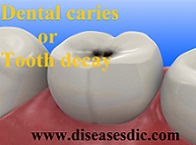Description
Dental caries can also be termed as tooth decay which is a microbial, progressive, and post-eruptive disease affecting the dental hard tissues resulting in inorganic constituent decalcification and dissolution of organic compounds. It is a dynamic process where both the demineralization and remineralization occurs simultaneously. When the rate of demineralization is greater than the remineralization rate, a cavity is formed. Typically dental caries can be spotted only in two specific areas of the teeth :
Occlusal carries, which forms on the top of the tooth where the mastication of food happens.
Interproximal caries, which are forms between the teeth, an area where the bacteria resides.
Pathophysiology and stages of tooth decay
‘Caries process’ is the term given to continues sequence of changes at the junction of each tooth. The interface between each tooth a layer of plaque or biofilm builds up.
- Demineralisation: Cariogenic bacteria in the plaque biofilm convert sugars into harmful acids that lower the pH below the critical level (pH- 5.5) and initiate the demineralization.
- Early lesion: tooth enamel is in a constant state of demineralization and remineralization. If the net time spent demineralizing is greater than that spent remineralizing, early white-spot lesions can form.
- Cavitation: Early caries starts to form as a result of the enamels long exposure to acidic pH, constantly enduring the demineralization process and losing strength and structural integrity.
Causes and Risk factors
- Poor oral hygiene practices
- Dental plaque
- Bleeding gums
- Poor alignment of the bite cause damage to enamel thickness
- People who get their permanent teeth earlier in life are at greater risk for cavities
- Deep tooth crevices and enamel issues
- Less thickness of enamel
- Crooked and overlapped teeth
- Improper nutrition
- Bedtime feeding
- Frequent snacking or sipping
- Not getting enough fluoride
- Sugary Foods
- Acidic foods and drinks
- Lack of saliva and dry mouth issues
- Heartburn
- Tooth grinding
- Genetics
- Age
History
1510 to 1590 – Frenchman Pare declared that a toothache was due to internal forces of hot or cold that resulted in caries.
1678 to 1761 – Pierre Fauchard, was one of the first to prefer the more technical term of caries.
1700 to 1800 – using histological preparation and stain technology, it is identified that caries was caused by external chemical agents.
1835 – Robertson, described that the caries was caused by the chemical disintegration of a tooth.
Symptoms of dental caries
Symptoms vary depending upon the density and their location on the teeth. Symptoms of dental caries include:
- Sensitive tooth
- Cavity or pit in your teeth’s
- Pain while biting any down any food
- Pain that causes without any apparent cause
- Black, brown or white staining on the head of the teeth
- Mild sharp pain when eating or drinking something
Complications
- Continuous tooth pain
- Tooth abscess become infected and trigger invasion of infection into the bloodstream cause sepsis
- Chewing food is very much difficult
- Increased risk of tooth chipping
- Pus production around infected tooth
- Gum disease (gingivitis)
Diagnosis and tests
Some of the diagnosis and tests for dental caries include:
- Your dentist may usually do the physical examination in your mouth.
- Asking about history of pain and sensitivity
- By using dental instruments doctor may check the soft areas
- Taking dental X-rays, which can show the extent of cavity and tooth decay
Treatment for dental caries
There are four main ways to treat dental caries include:
Crowns: It is used when teeth decay goes severe. Your dentist may place a cap on your tooth to replace the natural crown.
Root canal: Another method of treatment that can get rid of dental caries is called root canal treatment. If the pulp of the teeth is gravely affected by the decay, your doctor may perform root canal treatment. It involves the removal of the tooth along with the decayed portion and sealed with sealing material.
Root canal treatment
Tooth filling: There are different materials used for filling the tooth such as composite resin and amalgam. It is made from silver, copper, mercury and other metals, while these materials look like a tooth color so it will give better appearance
Extraction: sometimes tooth may decay even after repair. In that case, the tooth must be extracted before it gets infected other places in the mouth. The removal of teeth may affect the alignment of the other teeth in the mouth. So, in this case, the dental implants can be used such as bridge and partial denture.
Prevention of dental caries
- Brush your teeth with fluoride toothpaste for twice a day mainly after a meal
- Rinse your mouth with fluoride
- Visit your dentist regularly, do oral cleaning and regular oral exams, which can prevent dental problems
- Avoid frequent snacking and sipping
- Eat tooth healthy foods
- Chewing gum that contains xylitol helps to decrease bacterial growth
- Use of sealant in molar teeth’s

